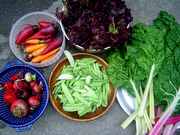

|
| Vegetable Varieties for Gardeners is a citizen science program
|
|
|
|
'Rainbow Inca' Corn |
| |
| Sub-Category: |
Other
Late Season
|
| |
Specialty Corn
|
| Sub-Category 2: |
| | Description: |
Unusual multi-colored, late-season sweet corn. 7- to 10-foot plants bear with purple, red, yellow, blue and white kernels. Harvest fresh for sweet corn or dry for ornamental use.
|
| Days To Maturity: |
85-120
|
| Seed Sources: |
|
| |
| Rating Summary |
| |
Overall: (3.5 Stars)
Taste: (4.0 Stars)
Yield: (3.0 Stars)
Ease/Reliability: (3.5 Stars) |
| |
| Reviews |
| |
Login to share your Review of Rainbow Inca.
Number of Reviews: 2
KEY: O=Overall Rating, T=Taste, Y=Yield, E=Ease
Reviewed on 08/20/2010 by
grc
- An intermediate gardener
|
 Overall Overall
 Taste Taste
 Yield Yield
 Ease Ease
|
Maricopa, Arizona, United States
Frost Free Season: More than 203 days
Soil Texture: Loam
Garden Size: Large - More than 1,600 square feet (40' x 40')
Sun Exposure: More than 8 hours per day
|
| Planted > 150 seeds and got < 20% germination so I replanted ... twice. Ended up with 80-90 plants of different ages. Seed was from two different sources so I don't think that caused poor germination; I may have rushed the season (planted to soon) fearing corn bred in OR from mostly high desert varieties may not like Phoenix summers. That did not turn out to be a problem. As a sweet corn (color develops after milk stage) this corn is fine (unless you like super sweet corn). I selected Rainbow Inca because it is open pollinated and can be used as a sweet or flour corn. I plan to grow it again next year ... starting a month later and augmenting saved seed with more purchased seed. I notice two vendors had "crop failures" and will not sell for the 2011 season. There appears to be huge genetic variability in Rainbow Inca and I am hoping to improve my luck with the seed saved from corn that did best in my situation. I planted this corn in a "3-sister" environment (with beans and squash). If you want to do the same plant Hopi Black Beans or Lima beans at the same time as the corn but plant traditional "cornfield beans" (like rattlesnake) after giving the corn the commonly recommended head start. |
| |
|
Reviewed on 04/02/2009 by
drywoodman
- An experienced gardener
|
 Overall Overall
 Taste Taste
 Yield Yield
 Ease Ease
|
Vernon, Missouri, United States
Frost Free Season: 123 - 143 days
Soil Texture: Sand
Garden Size: Large - More than 1,600 square feet (40' x 40')
Sun Exposure: More than 8 hours per day
|
|
To me by far the best open pollinated sweet corn I have tried or grown. It deserves a 5 in the OP class. Mine came on more around the 85 day mark and produced nice white ears that turn rainbow colored after the milk stage. I have found it still to be edible in the dough stage. There is no comparison in sweetness to the new over sweetened varieties, but compared to like Silver Queen I see not much difference. |
| |
|
|
|
|
Vegetable Varieties for Gardeners is a citizen science program, © 2004-2024, All Rights Reserved
Cornell Garden Based Learning, Cornell University College of Agriculture & Life Sciences, Horticulture Section
|






 VVfG home
VVfG home
 Yield
Yield
